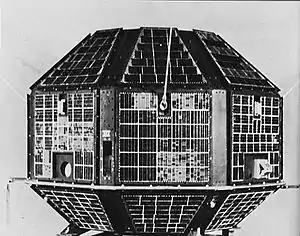| Mission type | Communication |
|---|---|
| Operator | New Space India Limited[1][2] |
| Mission duration | 15 years (estimated) |
| Spacecraft properties | |
| Bus | I-3K Bus |
| Manufacturer | ISRO Satellite Centre Space Applications Centre |
| Power | 2 solar array batteries |
| Start of mission | |
| Launch date | Q2 2024 (planned)[3] |
| Rocket | Falcon 9 Block 5 |
| Launch site | Cape Canaveral, SLC-40/LC-39A |
| Contractor | SpaceX |
| Orbital parameters | |
| Reference system | Geocentric |
| Regime | Geostationary |
| Longitude | 55° East |
GSAT-20 also known as CMS-03 or GSAT-N2 is a communication satellite jointly being developed by Indian Space Research Organisation Satellite Centre and Liquid Propulsion Systems Centre.[4] GSAT-20 is funded, owned and operated by New Space India Limited, though the communication capacity will be leased to Dish TV.[5][6][7] The satellite is intended to add data transmission capacity to the communication infrastructure required by India's Smart Cities Mission.
It will be India's first satellite to rely entirely on electric propulsion, which can be five to six times more efficient than chemical-based propulsion.[4]
Payload
The satellite features a Ka-band high-throughput communications payload with 70 Gbit/s[8] throughput utilizing 40 beams, offering HTS capacity of nearly 48Gbps.[9] Each beam will have 2 polarisations, effectively making them 80 beams.[10]
Launch
The satellite was initially expected to be launched in 2024 on an LVM3,[11][12][13] but the satellite is ~700kg heavier than the maximum capacity of LVM3.[3]
As a result, the commercial arm of ISRO (New Space India Limited) signed a contract with SpaceX to launch GSAT-20 aboard Falcon 9 in the second quarter of 2024. The deal signifies a significant shift for ISRO, which until now has relied on Arianespace to launch satellites too heavy to fly on domestic launch vehicles.[3]
See also
References
- ↑ Kumar, Chethan (18 February 2021). "Space PSU NSIL to launch satellite for TataSky". The Times of India. Retrieved 22 February 2021.
- ↑ "Annual Report 2017-18, Department of Space". ISRO.gov.in. Department of Space, Government of India. Archived from the original on 14 February 2018. Retrieved 13 February 2018.
- 1 2 3 Foust, Jeff (2 January 2024). "India selects Falcon 9 for communications satellite launch". SpaceNews. Retrieved 4 January 2024.
- 1 2 D.S, Madhumathi (1 May 2017). "GSAT-9 heralds cost-saving electric propulsion". The Hindu. Bengaluru. The Hindu. Retrieved 27 May 2017.
- ↑ "News | NSIL". www.nsilindia.co.in. Retrieved 2 January 2024.
- ↑ Kumar, Chethan (18 February 2021). "Space PSU NSIL to launch satellite for TataSky". The Times of India. Retrieved 22 February 2021.
- ↑ "Space PSU NSIL to launch GSAT-20 on SpaceX's Falcon 9 this year". The Times of India. 3 January 2024. ISSN 0971-8257. Retrieved 3 January 2024.
- ↑ Nair, Avinash (17 May 2017). "ISRO's GSAT-trio to usher in high-speed internet era". The Indian Express. Ahmedabad. Retrieved 27 May 2017.
- ↑ "GSAT-20". space.skyrocket.de. Retrieved 27 May 2017.
- ↑ Vasudeva, Akshay (22 May 2017). "India to enter high-speed internet era with Isro's new satellites". India: mi.com. Archived from the original on 21 January 2018. Retrieved 27 May 2017.
- ↑ "ISRO planning to launch second development SSLV flight in Feb: S Somanath". Mint. 4 January 2023. Retrieved 6 January 2023.
To facilitate in-flight connectivity for automobile services using the Ka-band the space agency is planning to launch the GSAT-20 high throughput satellite next year.
- ↑ "Coming soon, higher internet speeds". @businessline. Retrieved 16 November 2018.
- ↑ "Annual Report 2018" (PDF). ISRO. Archived from the original (PDF) on 28 May 2019. Retrieved 28 May 2019.
